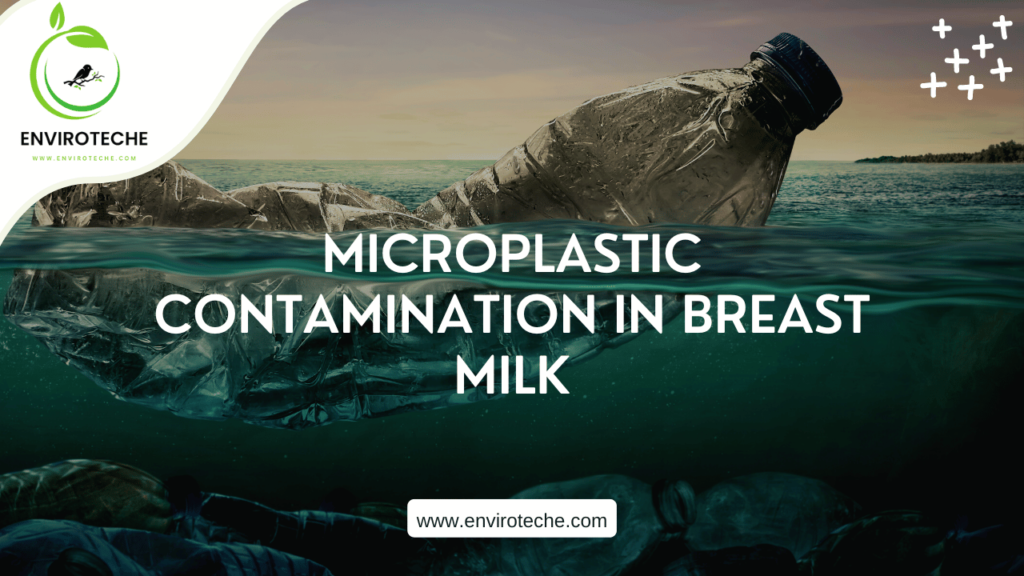
Aneeza Ishfaq1, Qudrat Ullah1
1Department of Environmental Sciences, Government College University Faisalabad
Introduction
The presence of microplastics in breast milk has recently come under investigation, raising the possibility of a concerning link between plastic pollution and human health. There is currently research being done to determine whether microplastic particles are present in breast milk, which is widely acknowledged as the best source of nutrition for infants (Malafaia & Barceló, 2023). The magnitude of human exposure to microplastics and the possible effects on nursing moms and infants are both raised by this occurrence.
The Presence of Microplastics
Microplastics have been found in samples of breast milk taken from mothers around the world, according to scientific investigations (Sazakli & Leotsinidis, 2019). These minute plastic particles are identified and measured by researchers using specialized methods like spectroscopy and microscopy. The investigations show that this essential infant food source has been contaminated with microplastics, which are defined as plastic bits smaller than 5 millimeters.
Sources and Routes of Contamination
Breast milk possibly contains microplastics from a variety of sources. Understanding the sources and pathways of mp contamination in breast milk is essential for finding solutions. The following list covers important sources and pathways for microplastic contamination.
- Food and Beverages
Consuming foods and drinks that have microplastic contamination increases exposure significantly. Fish and shellfish that have been exposed to microplastics can also be consumed, as well as water and other drinks. Production, processing, and packaging processes are only a few of the steps where contamination can happen.
- Environmental Pollution
Plastic pollution in the environment is a major source of mp contamination. When plastic waste is discarded or improperly managed, it can degrade into smaller particles over time, including microplastics. These tiny plastic particles can enter water bodies, such as rivers, lakes, and oceans, through various pathways like runoff from land, sewage systems, and improper waste disposal practices.
Once in the water, mp can be transported and dispersed, ultimately becoming part of the marine and freshwater ecosystems. The contamination can then enter the food chain as aquatic organisms consume the mp, and these organisms are subsequently consumed by larger organisms, including humans. Thus, plastic pollution in the environment is a primary source of mp contamination in various ecosystems, including the potential presence of microplastics in breast milk.
- Atmospheric Deposition
MP can be carried via the air and deposited on a variety of surfaces, including vegetation, soil, and bodies of water. Wind and rains can transport microplastics from metropolitan areas, industrial locations, and plastic waste storage or disposal sites into the atmosphere.
- Personal Care Products
Microbeads, which are small plastic particles found in personal care products such as exfoliating scrubs, toothpaste, and cosmetics, can also contribute to mp contamination. These microbeads are frequently swept down drains and enter wastewater systems, where they may not be efficiently filtered out during treatment operations.
- Household Items and Synthetic Fibers
Plastic household goods, such as packaging materials, fabrics, and synthetic fibres, can shed microplastic particles. For example, when synthetic clothes is washed, microfibers are released into the wastewater and eventually end up in the environment.
- Maternal Exposure and Body Burden
Maternal exposure to microplastics via numerous pathways, such as inhalation, Skin absorption, and ingestion, can also contribute to microplastic contamination in breast milk. Personal habits, vocations, and lifestyle choices can all have an impact on the level of exposure and subsequent contamination.
Potential Health Implications
The potential health consequences of mp contamination in breast milk are a significant source of worry. While research is still in its early phases, various possibilities have been proposed. Microplastics may have an impact on newborn health through a variety of processes, including inflammation, oxidative stress, and endocrine disruption. Concerns have been raised about potential developmental implications, immune system dysregulation, and long-term health ramifications for newborns(Zhang et al., 2023).
Microplastic Contamination Influencing Factors
Several factors can influence mp contamination levels in breast milk. Understanding these elements is critical for establishing effective mitigation methods (Liu et al., 2023). The following are some important elements that influence mp contamination:
Geographical Location: The geographical location has a considerable impact on the levels of mp pollution. Plastic pollution is more prevalent in areas with a high population density, industrial activity, and inadequate waste management systems, which may contribute to increased mp contamination in the environment and, as a result, in breast milk.
Lifestyle Choices and Behaviors: Individual lifestyle choices and behaviors can have an impact on mp exposure and contamination. Consuming seafood that is susceptible to microplastic contamination, for example, or relying extensively on processed and packaged meals, can also increase exposure. Personal habits such as the use of plastic products, cosmetics containing microbeads, or synthetic clothing can all contribute to mp pollution.
Maternal Diet: A important factor that may influence mp contamination in breast milk is maternal diet. According to research, a diet high in seafood, particularly seafood known to be contaminated with microplastics, can increase the risk of microplastics in breast milk. A varied and balanced diet that emphasizes fresh, minimally processed foods might help reduce exposure.
Maternal Exposure: Maternal exposure to mp via multiple methods can contribute to breast milk contamination. Inhaling mp-contaminated air, skin absorption via direct contact with plastic products, and consuming contaminated food and beverages can all lead to increased exposure and subsequent contamination in breast milk.
Breastfeeding Practices: Breastfeeding practices have the potential to affect mp contamination in breast milk. Microplastic levels in breast milk can be influenced by factors such as breastfeeding length, frequency of feeding, and maternal health. Despite the presence of mp, it is crucial to emphasize that breastfeeding continues to provide several health benefits for newborns.
Individual Variability: Individual variability, including metabolic, genetic, and physiologic factors, can also influence microplastic contamination levels. Because each person’s body reacts differently to mp exposure, the levels of microplastics identified in breast milk may vary.
Mitigation and Future Directions
Microplastic contamination in breast milk necessitates a diversified strategy. Individuals may help by limiting their use of plastic, choosing sustainable alternatives, properly disposing of plastic waste, and supporting regulations that promote plastic waste management. Governments and companies should enact stronger laws to reduce plastic manufacture, boost recycling, and promote environmentally friendly practices. More study is needed to better understand the health impacts of microplastic exposure and to create appropriate mitigation solutions.
Empowering Mothers and Caregivers
Mothers and carers can take actions to reduce their children’s exposure to microplastics. Choosing fresh, minimally processed meals, avoiding excessive use of plastic containers and packaging, and opting for natural and eco-friendly personal care items are all examples of this. Despite the presence of microplastics, breastfeeding remains the best option for newborn nourishment due to its various benefits. It is critical to give breastfeeding moms with support and resources, emphasizing the need of a healthy lifestyle, a well-balanced food, and adequate water.
Conclusion
The discovery of a link between microplastic pollution and breast milk is unsettling. While the long-term health ramifications are still being researched, addressing plastic pollution and reducing our reliance on single-use plastics is critical. We can strive towards a cleaner environment and a healthier future for both infants and breastfeeding mothers by taking individual acts, supporting collective initiatives, and lobbying for governmental changes. To handle this rising challenge and protect human health, more study, public awareness, and preventive measures are required.
References
Liu, S., Guo, J., Liu, X., Yang, R., Wang, H., Sun, Y., Chen, B., & Dong, R. (2023). Detection of various microplastics in placentas, meconium, infant feces, breastmilk and infant formula: A pilot prospective study. Science of The Total Environment, 854, 158699.
Malafaia, G., & Barceló, D. (2023). Microplastics in human samples: Recent advances, hot-spots, and analytical challenges. TrAC Trends in Analytical Chemistry, 117016.
Sazakli, E., & Leotsinidis, M. (2019). Possible effects of microplastics on human health. Microplastics in Water and Wastewater, Hrissi K. Karapanagioti, Ioannis K. Kalavrouziotis Download Citation File: Ris (Zotero) Reference Manager EasyBib Bookends Mendeley Papers EndNote RefWorks BibTex Close Search.
Zhang, Q., Liu, L., Jiang, Y., Zhang, Y., Fan, Y., Rao, W., & Qian, X. (2023). Microplastics in infant milk powder. Environmental Pollution, 323, 121225.
Check Other Schlorships:
